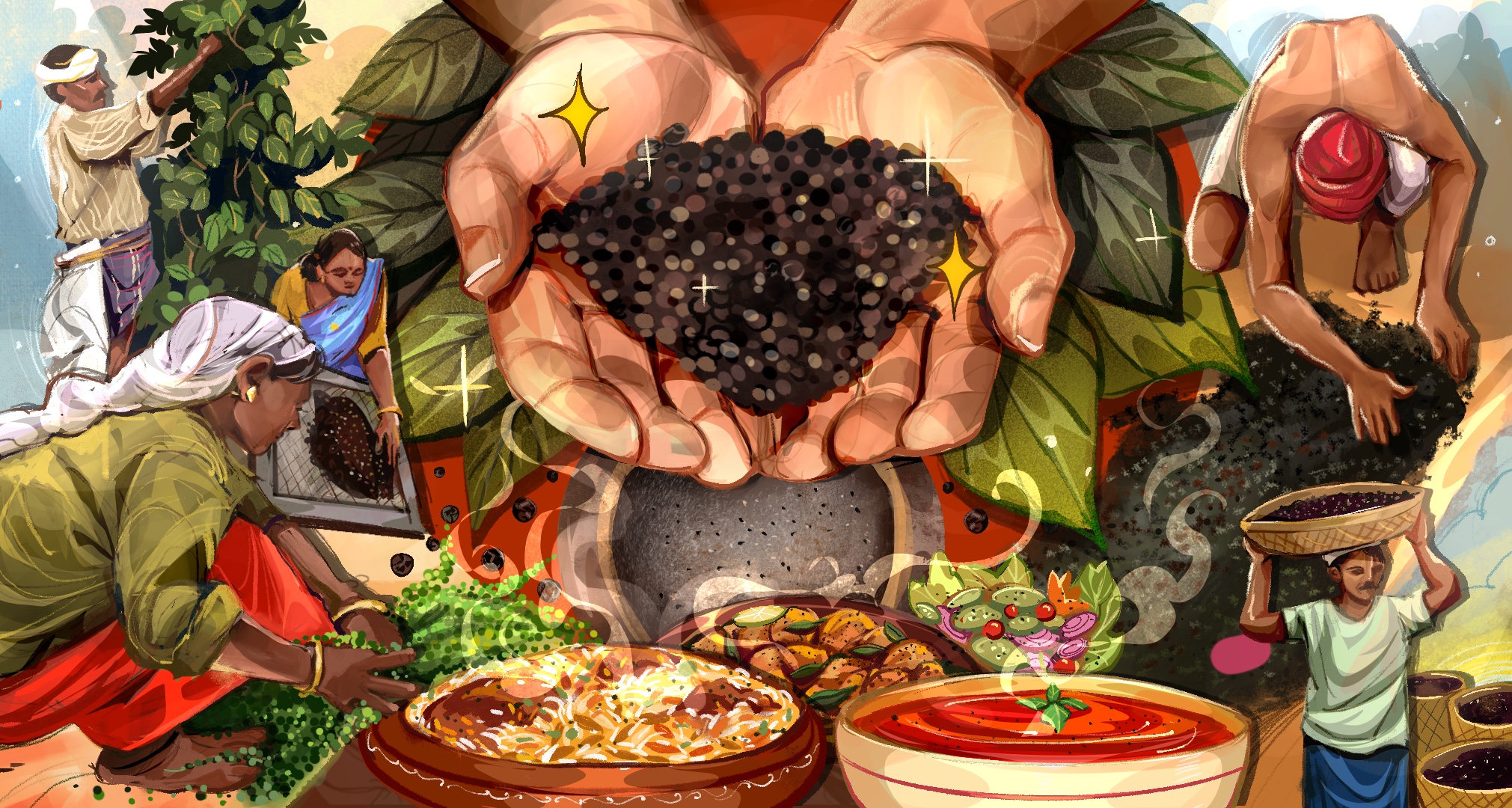Black pepper, often hailed as the ‘king of spices’, carries with it a rich history dating back to ancient times. Unlike its ubiquitous companion salt, black pepper owes its origins to the lush landscapes of Kerala, a state in southern India. Mentioned in Greek and Roman history, its influence stretches across civilisations. The spice not only adorned the tables of the Indian subcontinent but found its way to distant lands, fostering trade relations between Egypt and India as early as the time of the Egyptian Pharaoh Ramses the Great (1303-1213 BC). The narrative of peppercorns being part of Ramses’ mummification underscores the spice’s historical significance and its connection to India.

IndiaFirst Life Elite Term Plan

IndiaFirst Life Radiance Smart Invest Plan

IndiaFirst Life Elite Term Plan

IndiaFirst Life Radiance Smart Invest Plan

IndiaFirst Life Radiance Smart Invest Plan

-
Term Insurance
-
Term Insurance Plans
-
Income Based Term Plans
-
Term Insurance Coverage Options
Term Insurance Coverage Options

-
Term Insurance for EveryOne
-
Term Insurance For Coverage for all Ages
Term Insurance For Coverage for all Ages

-
Term Insurance Calculator
Term Insurance Calculator

-
Term Insurance Riders
Term Insurance Riders

-
Term Insurance Plans
-
Life Insurance Plans
-
Term Insurance Plan
-
ULIP Plans
-
Savings Plans
-
Retirement & Pension Plans
-
Guaranteed Returns Plans
-
Life Insurance Rider
-
Group & Corporate Life Insurance Plans
Group & Corporate Life Insurance Plans

-
Child Insurance Plans
Child Insurance Plans

-
Term Insurance Plan
-
Tools & Calculators
-
Learn
-
Claim
-
Support
-
$ Plans for NRI’s

No results for
Check that your search query has been entered correctly or try another search.

Let Us know a suitable time for you.
Ask an Expert to Buy Life Insurance
We're happy to know that you're prioritizing your family's future. Our life insurance expert will assist you in finding the best insurance plan. To schedule a call, please share some of the below details.
Male
Female
Other

Thank for submitting your details
Your insights play a crucial role in helping us improve and enhance our services.
03 Jan 2025
Origin & History of Black Pepper: The King Of Spices in India

Introduction
Pepper and Peppercorns
While often used interchangeably, it is crucial to distinguish between pepper and peppercorns. Peppercorns are the fruit of the Piper nigrum flowering vine, and black pepper is the result of grinding these peppercorns. The word ‘pepper’ itself has roots in Sanskrit (pippali), Latin (piper), and Old English (piper). Malabar, in India, was the first home for black pepper, with the finest Indian pepper continuing to hail from this region. Pepper’s presence predates even Alexander the Great and became a staple spice during biblical times. In the Middle Ages, it ascended to a newfound status in fine cooking and was considered a valuable commodity, demanded as ransom during historical events like the Huns’ siege of Rome in 410 CE.
The Pepper Vine
The pepper plant, a perennial climbing vine, thrives in the Malabar region due to ample rainfall, hot temperatures, and partial shade. These vines entwine around woody trees for support, reaching heights of about 10 metres with glossy green leaves. The delicate flowers grow in clusters, followed by the pungent fruit, peppercorns. It takes about three years for the vine to bear fruit and seven to eight years to reach maturity. The life span of a vine is approximately 20 years. Peppercorns come in different colours – green, black, and white – representing different stages of ripeness. The harvesting and processing methods determine their taste and colour. Green peppercorns, picked before full ripening, are used fresh or dried, retaining their unique colour. Black peppercorns, the most popular, result from drying immature green berries until wrinkled and black. Red peppercorns, fully ripened on the plant, turn red and are soaked, peeled, producing white peppercorns.
Varieties and Uses
Green pepper is frozen and dried for preservation, finding its place in soups and salads, while the processed food industry uses it in various preparations. Black pepper, a household name globally, is universally accepted in almost all savoury dishes. White pepper, with a milder taste, is used less frequently, catering to it those with a milder palate. Black pepper’s longer shelf life is attributed to spending less time on the vine compared to white pepper. Health-wise, both black and white pepper offer immense value, aiding digestion, battling bacterial growth, and providing remedies for colds and coughs. Black pepper, despite its fiery taste, is considered sweet in the digestive tract, boosting metabolism, aiding weight loss, treating skin problems, and reducing the risk of various ailments, including cancer.
Conclusion
In tracing the roots of black pepper, it becomes evident that India, particularly the Malabar region, played a pivotal role in its cultivation and popularity. The spice’s journey from ancient times, reaching the tables of distant civilisations, showcases India’s historical role as a culinary influencer. The flavours of black pepper, with its distinct stages of ripeness and varied uses, have added depth and richness to cuisines worldwide. As we savour the pungent warmth of black pepper, let us acknowledge and celebrate India’s contribution to the world’s palate, truly making it the ‘king of spices.
References
- Indian Culture
https://indianculture.gov.in/food-and-culture/spices-herbs/black-pepper-king-spices#:~:text=Black%20Pepper %20is%20considered%20the,in%20Greek%20and%20 Roman%20history
- World Food Story
https://www.worldfoodstory.co.uk/black-pepper-history#:~:text=Pepper%20originates%20 from%20Southern%20India,fruit%20which%20 gives%20spice%20%E2%80%93%20pepper
Find Your Favorite Topic
Subscribe to our Life+ newsletter for exclusive updates & smart financial guidance
विशेष अपडेट और स्मार्ट वित्तीय मार्गदर्शन के लिए हमारे लाइफ+ न्यूज़लेटर की सदस्यता लें
વિશિષ્ટ અપડેટ અને કુનેહભર્યા નાણાંકીય માર્ગદર્શન માટે અમારા લાઈફ+ ન્યૂઝલેટરને સબસ્ક્રાઈબ કરો
ప్రత్యేకమైన నవీకరణలు & స్మార్ట్ ఫైనాన్షియల్ గైడెన్స్ కోసం మా లైఫ్ + న్యూస్ లెటర్ సభ్యత్వాన్ని పొందండి.
निवडक अपडेट आणि उत्तम आर्थिक मार्गदर्शन मिळवण्यासाठी आमच्या लाईफ+ बातमीपत्राचे सदस्यत्व घ्या
பிரத்தியேக புதுப்பிப்புகள் மற்றும் ஸ்மார்ட் நிதி வழிகாட்டலுக்கு எங்கள் வாழ்க்கை + செய்திமடலுக்கு குழுசேரவும்

Thank you for subscribing to Life+ Newsletter!
Keep an eye on your inbox-great things are coming your way









